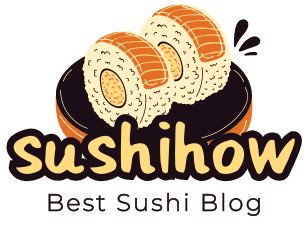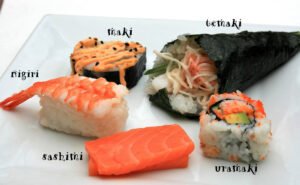Sushi comes in many varieties, each boasting their own distinct shape and flavor. Some come in the shape of traditional Japanese toy balls while others are wrapped with ingredients such as rice.
Temarizushi, which takes the shape of a handball, is created by spreading vinegared rice over nori sheets and filling it with fish or other ingredients. Other styles such as oshizushi are compressed in boxes for easier transport or narezushi is fermented using salt and rice to preserve fish for fermentation purposes.
Nigiri
Nigiri (which translates to “sushi rice topped with fish”) is one of the oldest forms of sushi. Vinegared sushi rice known as neta (pronounced Neh-tah) is delicately hand pressed into small mounds before being placed atop fresh pieces of raw fish that is typically consumed raw. This delicate process elevates sushi from being just another snack food into an experience worthy of exploration, as its subtle flavors pair beautifully with umami-rich fish offerings and spice-laden wasabi (Japanese horseradish).
As with other traditional Japanese cuisine, nigiri sushi can be best enjoyed when served with various accompaniments that enhance its variety of flavors. Soy sauce dunks, pickled ginger bites and wasabi splashes can all make your bite stand out among its peers!
Salmon (sake nigiri), tuna (maguro nigiri – with both prized fatty belly portions known as otoro and leaner meat known as akami), yellowtail (hamachi nigiri) and eel (unagi or anago nigiri) are some of the most popular options; eggs or avocado may also be served in smaller sizes for easier eating.
Maki
Contrasting with traditional sushi preparations such as sashimi or other forms of sushi that feature individual slices of fish or seafood, maki is an increasingly popular dish that combines ingredients with rice and seaweed to form an array of textures and flavors – perfect for dinner parties, buffets and catering events alike!
Maki starts with vinegared rice (shari), which typically consists of short-grain Japanese rice mixed with salt, sugar and rice vinegar to form its signature sticky texture. This seasoning provides subtle yet distinct notes that complement both fish and other toppings perfectly without overshadowing them.
Once the shari is in place, sushi chefs can add any number of ingredients depending on what kind of maki they’re creating – be they placed over or wrapped within it.
Some maki varieties combine raw and cooked food, while others feature one specific element – for instance, hosomaki is typically comprised of one fish fillet combined with cucumber or other vegetables for an appetizer that comes out crisp.
Maki varieties vary significantly in composition. Many can contain multiple food items at once – such as squid, avocado, cheese or kamaboko (Japanese fish cake). For an eye-catching dish try Kakinoha-zushi from Nara, an island region in Japan where leaves were once used to transport fresh seafood before refrigeration became widespread; leaving behind its aromatic fragrance which imparts this dish its signature aroma.
Chirashi
Though many associate sushi with raw fish, this delicious treat includes other elements as well. Along with traditional toppings like seaweed, pickled ginger and daikon (radish), shrimp and ikura (salmon roe) are among the more popular choices for chirashi sushi.
Chirashizushi is an elegant yet straightforward dish perfect for dinner parties. This stunning creation involves layering various toppings onto sushi rice in a shallow box or bowl; also known as barazushi or gomoku sushi; its name may differ depending on your region and may include prepared seafood like unagi rather than raw fish as an ingredient.
High-end Japanese restaurants and to-go containers often serve this style of chirashizushi, in which toppings are artfully arranged to highlight their color and texture. Tokyo’s Edo district features this dish by artfully layering raw accompaniments over the rice for decorative effect; gomoku chirashizushi from Kansai region contains both raw and cooked components that come together into an edible rice salad form.
At home, when creating this chirashi dish it is essential to begin by prepping all of the necessary ingredients well in advance and then assembling your sushi just prior to serving. Fluff your rice prior to this step to release excess moisture and ensure it remains fluffy while also protecting it from becoming overly soft.
Funa
Although sushi may be best known for maki rolls and nigiri, its variety is far greater than many people realize. Beginning with its foundation – vinegared rice known as shari – which serves as the basis for any toppings such as fish. Short grain varieties of the grain are used and lightly flavored with vinegar, sugar and salt for subtle yet distinctive flavor notes that allow raw fish to shine.
Ebi, or herring roe, is an indispensable ingredient in most types of sushi and often serves as the centerpiece for nigiri dishes. Common varieties include large, fleshy kuruma-ebi; sweet translucent ama-ebi; and highly sought after botan-ebi which comes with its signature gradient pink coloring.
Sushi dishes often feature other forms of plant foods as well, including pickled daikon radish (takuan) in shinko maki; cucumber in kappa maki; and fermented soybeans (natto) for the natto maki variety.
Temarizushi (or “ball sushi”) is another overlooked form of sushi. Consisting of small rounds of pressed rice topped with fish and other ingredients, its name refers to the Japanese tradition of embroidering balls known as temari. Popular as party foods or picnic treats alike, Hinamatsuri (girl’s day celebration) requires this simple yet decorative treat!



